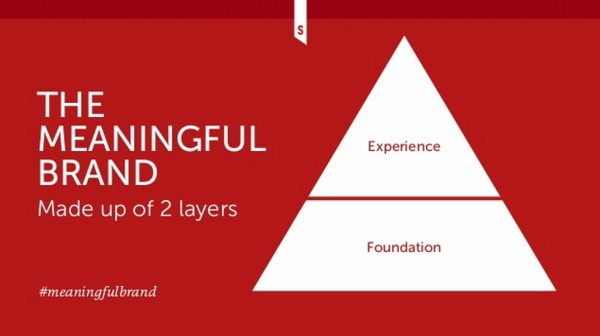A few weeks back I attended Mixwest in Indianapolis. One of the presenters, Melissa Balkon, had a wonderful session about building a meaningful brand. Her presentation was focused on the external brand BUT there were a lot of great takeaways for those looking to define their company’s internal brand.
First is Melissa’s definition of a brand: “Your audience’s collective impression of you.” Now let’s sub out “audience’s” with “employees.'”
So the definition for an internal brand would be “your employees’ collective impression of you (the company).” What does this collective impression look like where you work?

Melissa identified two key layers of any brand (internal or external). The foundation layer is made up of the core beliefs or ideas that describe who your company is. The experience layer includes the ways you execute on the beliefs and ideas. Simplifying this a lot, it sounds like “Walk the walk. Talk the talk.” Is what your company says it is and believes really how your it acts?
And you can break the foundation layer into three components:
- Values: Your deeply held beliefs. When employees understand what a company values, they will make smarter, quicker decisions – leaving out ambiguity or mistrust.
- Style: Your unique personal character. The more unique a company’s style, the more differentiated it will be. And while this can draw customers, it can also attract employees.
- Purpose: The reason your company exists. Many will say their company exists to make money. And while that’s partially true, it’s not the point of purpose. What would your customers say you do well? I’m confident it will point back to employees.
The brand experience layer can also be divided up into three areas where corporate communicators should have the most influence:
- Interaction: how your brand experience is translated through action. This is about refinement, consistency and creativity. I think to how corporate leaders interact with employees. Look at how Richard Branson views his employees. And then look at your leaders. Interaction can always be improved.
- Visual: how your brand experience is translated visually. No doubt, communicators can up their game here. Even if you make your internal communication LOOK more interesting, people will take notice, with photography and video being the key.
- Verbal: how your brand experience is translated verbally. So often, employee communication sounds and reads a lot like this Weird Al Yankovic video. It’s an experience, but not a good one.
I’m not suggesting that communicators can simply define the internal brand in a vacuum. Not at all. But you can be a catalyst for helping your company define what it’s internal brand is and/or what it wants it to be. There can be a large disconnect here and this is the place where corporate communications can add tremendous value. There will likely be some difficult conversations but through those change is delivered.
Melissa Balkon’s full Mixwest presentation: